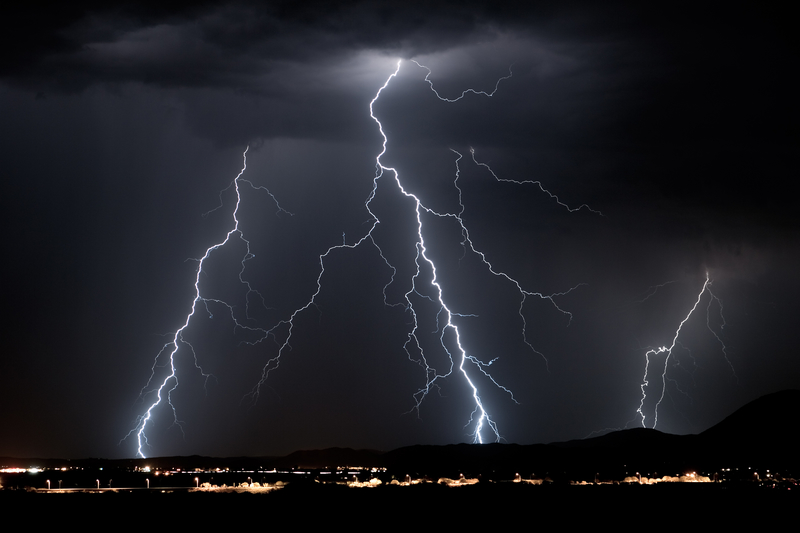In our minds, the possibility of lightning striking us seems slim to none. After all, how many times a year do you actually read about someone dying from a lightning strike? In reality, and as the people below will attest, it's much easier to be struck by lightning than you think. Regardless of whether you spend a large amount of time in the wilderness or not, you must realize the importance of keeping yourself out of lightning's path.
Sometimes they'll keep the clothing, the strips of shirt or trousers that weren't cut away and discarded by the doctors and nurses.
In this way, Jaime Santana's family have stitched together some of what happened that Saturday afternoon in April 2016.
Jaime had been horse-riding with Alejandro Torres in the mountains behind Alejandro's home outside Phoenix, Arizona.
They had witnessed quite a bit of lightning as they neared Alejandro's house, enough that they had commented on the dramatic zigzags across the sky. But scarcely a drop of rain had fallen.
Alejandro doesn't think he was knocked out for long. When he regained consciousness, he was lying face down on the ground, sore all over. His horse was gone.
The two other riders appeared shaken but unharmed. Alejandro went looking for Jaime, who he found on the other side of his fallen horse. Alejandro brushed against the horse's legs as he walked passed. They felt hard, like metal, he says.
Alejandro reached Jaime: “I see smoke coming up — that's when I got scared.” Flames were coming off of Jaime's chest. Three times Alejandro beat out the flames with his hands. Three times they reignited.
It wasn't until later, after a neighbor had come running to help and the paramedics had arrived, that they began to realize what had happened — Jaime had been struck by lightning.
Jaime had arrived at the Phoenix trauma center with an abnormal heart rhythm, bleeding in the brain, bruising to the lungs and damage to other organs, including his liver. Second- and third-degree burns covered nearly one-fifth of his body. Doctors put him into a chemically induced coma for nearly two weeks to allow his body to recover.
Jaime finally returned home after five months of treatment and rehabilitation, which is continuing. “The hardest part for me is that I can't walk,” he says from the living room of his parents' house. The doctors have described some of Jaime's nerves as still “dormant”, says Sara, something that they hope time and rehabilitation will mend.
A second survivor's tale
An avid fisherman, Justin had initially been elated when the rain started that August afternoon. But when it picked up, becoming stronger and then turning into hail, his wife and daughter headed for the truck, followed later by his son.
A crashing boom. Jolting, excruciating pain. “My whole body was just stopped,” Justin recalls. “If you've ever put your finger in a light socket as a kid, multiply that feeling by a gazillion.”
When Justin came to, he realized that he too was paralyzed from the waist down. “Once I figured out that I couldn't move my legs, I started freaking out.” It took five hours for the paralysis to subside.
Describing that day, Justin traces the path of his burns, which at one point covered roughly a third of his body.
He shows me his hiking boots, tipping them to reveal several burn marks on the interior.
The consequences of surviving
Lightning is responsible for more than 4,000 deaths worldwide annually, though of every ten people hit, nine survive. But victims can suffer a variety of short- and long-term effects: cardiac arrest, confusion, seizures, deafness, headaches, memory deficits, personality changes and chronic pain, among others.
Changes in personality and mood can strain families and marriages, sometimes to breaking point.
Electricity and your body
When someone is hit by lightning, it happens so fast that only a very tiny amount of electricity ricochets through the body.
As it moves over the body, it might come into contact with sweat or raindrops on the skin's surface. Liquid water increases in volume when it's turned into steam, so even a small amount can create a ‘vapor explosion'. “It literally explodes the clothes off,” says Cooper.
Lightning's massive electrical current can also temporarily stun the heart, says Chris Andrews, a physician and lightning researcher at the University of Queensland in Australia.
The problem is that lightning can also knock out the region of the brain that controls breathing. This doesn't have a built-in reset, meaning a person's oxygen supply can become dangerously depleted.
How it begins
Prime candidates include isolated and pointed objects: trees, utility poles, buildings and occasionally people, though direct strikes are surprisingly rare. They're responsible for no more than 3 to 5 per cent of injuries.
Justin, however, believes he experienced what's called a side splash, in which the lightning ‘splashes' from something that has been struck — such as a tree or telephone pole — hopscotching to a nearby object or person.
Considered the second most common lightning hazard, side splashes inflict 20 to 30 per cent of injuries and fatalities.
By far the most common cause of injury is ground current, in which the electricity courses along the earth's surface.
What to do in a thunderstorm
Avoid mountain peaks, tall trees or any body of water. Look for a ravine or a depression. Spread out your group, with at least 20 feet between each person. Don't lie down, which boosts your exposure to ground current.
There's even a recommended lightning position: crouched down, keeping the feet close together.
But there's no such thing as a lightning-proof guarantee, Holle states. So today, the advice is much simpler: “When thunder roars, go indoors.”
Have you had an unusual experience with lightning?
Article Source: CNN


Been their done that